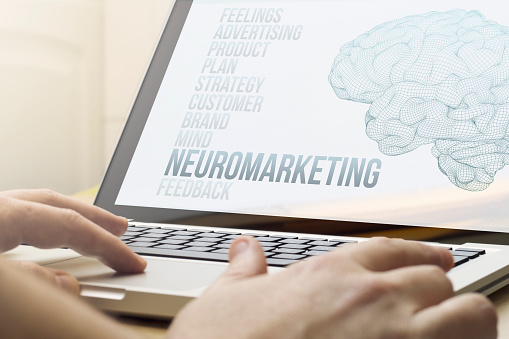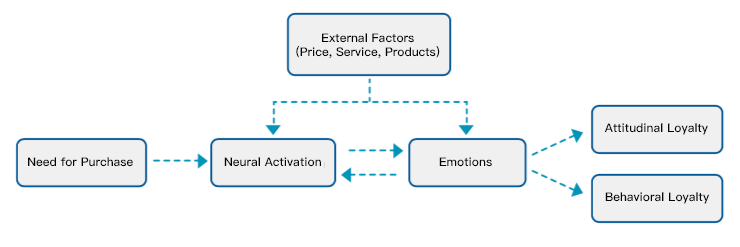Editor’s note: Ceri-Ann Hughes is research executive at research firm B2B International. Hughes works out of the company's U.K. office.
The Net Promoter Score (NPS) has largely monopolized the assessment of loyalty in market research and is often used as a stand-alone measure of performance by organizations. Despite this, we rarely look past the score to the underlying reason behind the rating. In recent years, it has been realized that brand loyalty may not only be driven by external factors but also by emotions and brain activation on a deeper level. By looking through the lens of neuromarketing we can gather new insight into loyalty to complement the use of NPS in market research.

The NPS metric measures how likely a customer is to remain loyal to the brand in question. Yet, what is loyalty? Defining loyalty in the traditional NPS sense places a strain on the metric as it has the responsibility of covering all aspects of loyalty. Some scholars suggest that loyalty is not one stand-alone concept but rather a collective term for a variety of customer attitudes, opinions and behaviors(1). Across these aspects, customers are thought to vary on the degree of loyalty they exhibit. If we consider this, the extent to which we can assess loyalty as a whole in one or two questions seems rather slim. Perhaps instead we should ask which factors are influencing the decision to remain loyal.
Initiating change based on the NPS score and follow-up questions (“Why do you say that?”) might be more complex than it appears due to the intricacies of this decision-making process. Let’s look at an example: one of the top reasons for defection to a business may be price. Switching cost structures in the face of this is unlikely to solve any loyalty issues in the opinion of scholars. An interesting investigation assessed the effectiveness of a lower price on loyalty and satisfaction, finding ultimately that lowering costs does not raise NPS or satisfaction scores unless the customer is already loyal to the business(2). Perceived value of the product or service was a more effective way to mediate the score. It appears that attitudinal loyalty to the brand through the NPS question may not actually reflect the behavioral loyalty of customers. So, what is driving loyalty?
Turning to neuromarketing
 Neuromarketing has been sweeping the marketing research industry in recent years. The discipline looks to complement the advancement of market research through evidence from psychology and neuroscience. An interesting focus of attention in the case of NPS is how emotions – positive or negative – can influence the decision to remain loyal. Both positive and negative emotions mediate the relationship between purchase and continued loyalty. Following emotional arousal, the customer is particularly susceptible to external factors which may influence attitudinal loyalty(3). This emotion-based satisfaction with service can be a strong predictor of future behavioral loyalty – perhaps even more so than cognitive-based assessment. Here, service level acts as an external factor influencing behavioral loyalty through initiating a strong emotional response, be it positive or negative.
Neuromarketing has been sweeping the marketing research industry in recent years. The discipline looks to complement the advancement of market research through evidence from psychology and neuroscience. An interesting focus of attention in the case of NPS is how emotions – positive or negative – can influence the decision to remain loyal. Both positive and negative emotions mediate the relationship between purchase and continued loyalty. Following emotional arousal, the customer is particularly susceptible to external factors which may influence attitudinal loyalty(3). This emotion-based satisfaction with service can be a strong predictor of future behavioral loyalty – perhaps even more so than cognitive-based assessment. Here, service level acts as an external factor influencing behavioral loyalty through initiating a strong emotional response, be it positive or negative.
To further this observation on the importance of emotion in the NPS question we can assess neural links associated with loyalty. The most loyal customers form deep affective bonds with their company of choice(4). These bonds are formed when the customer is given the opportunity to have an emotional experience with the company. This might sound strange due to the apparent lack of emotion in B2B markets. However, this emotional event can be as small as personalizing an account or rep involvement. This emotional involvement can build the foundation for true loyalty, both behavioral and attitudinal. Loyalty to this extent can have physiological implications. Brain imaging has highlighted that truly loyal customers would make a decision of purchase through an emotionally-based pathway in the cortex, while this was not the case in non-loyal customers(4). Further, truly loyal customers can make a brand decision with fairly little brain activation as the decision is effortless(5). While neuroimaging in market research is highly impractical, and largely impossible, observing academic work on the brain can provide us with a deeper understanding of the questions we are asking. The affective basis of loyalty is gathering momentum in market research, so delving into the multidisciplinary academic approach may provide insights into how we may better structure our questionnaires.
The role of external factors
In the assessment of the neural correlates associated with loyalty we can also take into account the role of external factors, such as price and product. For truly loyal customers, the mere presence of the brand logo can activate the reward pathway in the brain, though not that of non-loyal customers. Non-loyal customers are more likely to be swayed by the price of the product or service(4). Although loyal customers pay attention to a wide variety of products(6), they demonstrate simultaneous activation of both emotion and pre-purchase assessment regions in the frontal cortex, suggesting that their loyalty is driven by emotion. Playing to customers’ affect in surveys could be a manner in which to cover the base of loyalty powered by emotion in B2B research. A proposed question to assess emotion in addition to NPS is:
“Thinking about your overall relationship with [INSERT BRAND] right now, how warmly do you feel toward [INSERT BRAND]? Please use the 0-100 centigrade scale, where 0 is cold and represents very strong negative feelings and 100 is hot and represents very positive feelings.”
Incorporating questions like this into our B2B research means that we have the capability to gather more insight into the customer’s emotions and can assess the congruence of emotion with the NPS measure of loyalty. Again, however, we must attempt to move past the assessment of attitudinal loyalty and be able to predict behavioral loyalty.
New measures to assess loyalty
Evaluating loyalty using neuromarketing highlights the depths to which true loyalty reaches, and the shallow nature of using NPS by itself. We can gather from academia that loyalty may not be such a straightforward assumption – rather it is split into several facets.
Figure 1: Neural activations and emotions mediate both behavioral and attitudinal loyalty

Loyalty is mediated by emotion and its associated neural correlates (Figure 1), which are largely overlooked in B2B research. To achieve the most from our research we need to challenge existing metrics and be flexible in the addition of new measures to assess loyalty. By doing so we will have a better opportunity to attain a greater depth of information.
- Rundle-Thiele, S., 2005. “Exploring loyal qualities: assessing survey-based loyalty measures.” Journal of Services Marketing, 19(7), pp.492-500.
- Yang, Z. and Peterson, R.T., 2004. “Customer perceived value, satisfaction and loyalty: The role of switching costs.” Psychology & Marketing, 21(10), pp.799-822.
- Martin, D., O'neill, M., Hubbard, S. and Palmer, A., 2008. “The role of emotion in explaining consumer satisfaction and future behavioural intention.” Journal of Services Marketing, 22 (3), pp.224-236.
- Plassmann, H., Kenning, P. and Ahlert, D., 2007. “Why companies should make their customers happy: The neural correlates of customer loyalty.” ACR North American Advances.
- Schaefer, M. and Rotte, M., 2007. “Favorite brands as cultural objects modulate reward circuit.” Neuroreport, 18(2), pp.141-145.
- Lin, C.H., Tuan, H.P. and Chiu, Y.C., 2010. “Medial frontal activity in brand-loyal consumers: A behavior and near-infrared ray study.” Journal of Neuroscience, Psychology, and Economics, 3 (2), p.59.
- DeWitt, T., Nguyen, D.T. and Marshall, R., 2008. “Exploring customer loyalty following service recovery: The mediating effects of trust and emotions.” Journal of Service Research, 10 (3), pp.269-281.
